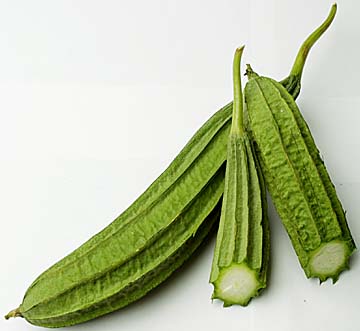

Key Ingredient

This squash resembles an okra on steroids, although it's not related to okra at all. Some say it tastes like zucchini, although the texture is a bit spongier. Luffa squash adds sweet
touch to soups and stewsLuffa squash -- also known as Chinese okra, sequa or sing qua, silk squash or hechima (in Japanese) -- is a favorite summer squash in the Asian diet. It's very low in calories and chock full of vitamin C and folate.
The basics: Luffa squash is a member of the gourd family and is closely related to cucumber, muskmelon and a variety of squashes. There are two varieties of luffa, one with smooth skin and one that has ridges.
Because of its fibrous nature, the smooth-skin variety is primarily used for industrial purposes to make mats, Asian slippers, stuffings and the popular natural sponge scrubber known as loofah. The ridged variety is enjoyed as a food crop, which is said to originate in India. This unique-looking squash grows narrow at one end and bulges at the other, with tough, dark green skin and soft white flesh. It can be eaten raw, but when cooked it takes on a silky sweet nature.
Selection: Look for young, relatively small squash that are firm and unshriveled.
Storing: Keep in the refrigerator for up to a week.
Use: Peel and cut away the hard exterior ridges. Although some say peeling is unnecessary for young squash, it still is a good idea to do so, especially if eating it raw.
Slice squash into circular pieces and use in soups, stews, curries and stir-fries. The squash cooks relatively quickly (don't overcook or it will get mushy). A popular Okinawan dish pairs the squash with pork or tofu and stews it in a white miso and sake sauce. Or, quickly parboil the squash then let it cool in the refrigerator. Slice thinly for namasu or sprinkle it with katsuo (bonito flakes) and a dash of shoyu for a healthy side dish.
Where to buy: You'll probably find luffa squash more readily in Chinatown or the farmer's markets, but because summer is the peak season, supermarkets carry them from time to time. Prices range from $1.69 to $2.29 a pound.
Food Stuffs: Morsels
Contact Eleanor Nakama-Mitsunaga
online at features@starbulletin.com
Asterisk (*) after nutritional analyses
indicates calculations by
Joannie Dobbs of Exploring New Concepts,
a nutritional consulting firm.